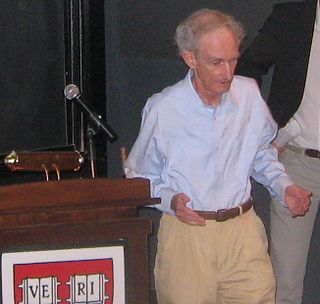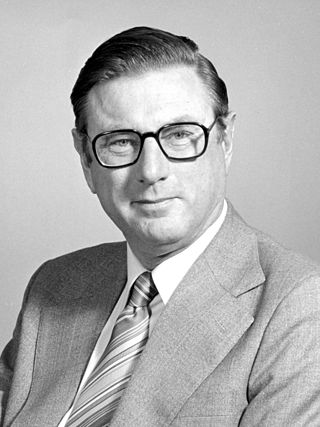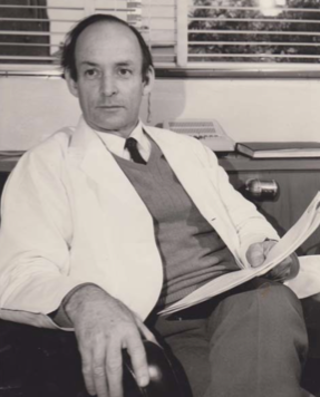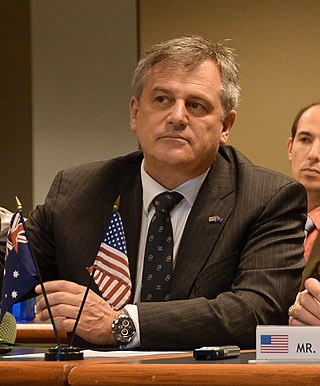Related Research Articles

Robert McCredie May, Baron May of Oxford, HonFAIB was an Australian scientist who was Chief Scientific Adviser to the UK Government, President of the Royal Society, and a professor at the University of Sydney and Princeton University. He held joint professorships at the University of Oxford and Imperial College London. He was also a crossbench member of the House of Lords from 2001 until his retirement in 2017.

Dr John Paul Wild AC CBE MA ScD (Cantab.) FRS FTSE FAA was a British-born Australian scientist. Following service in World War II as a radar officer in the Royal Navy, he became a radio astronomer in Australia for the Council for Scientific and Industrial Research, the fore-runner of the Commonwealth Scientific and Industrial Research Organisation (CSIRO). In the 1950s and 1960s he made discoveries based on radio observations of the Sun. In the late 1960s and early 1970s his team built and operated the world's first solar radio-spectrographs and subsequently the Culgoora radio-heliograph, near Narrabri, New South Wales. The Paul Wild Observatory at Culgoora is named after him.
Romaldo "Aldo" Giurgola AO was an Italian academic, architect, professor, and author. Giurgola was born in Rome, Italy in 1920. After service in the Italian armed forces during World War II, he was educated at the Sapienza University of Rome. He studied architecture at the University of Rome, completing the equivalent of a B.Arch. with honors in 1949. That same year, he moved to the United States and received a master's degree in architecture from Columbia University. In 1954, Giurgola accepted a position as an assistant professor of architecture at the University of Pennsylvania. Shortly thereafter, Giurgola formed Mitchell/Giurgola Architects in Philadelphia with Ehrman B. Mitchell in 1958. In 1966, Giurgola became chair of the Columbia University School of Architecture and Planning in New York City, where he opened a second office of the firm. In 1980 under Giurgola's direction, the firm won an international competition to design a new Australian parliament building. Giurgola moved to Canberra, Australia to oversee the project. In 1989, after its completion and official opening in 1988, the Parliament House was recognized with the top award for public architecture in Australia.

David Parker Craig, an Australian chemist, was the Foundation Professor of Physical and Theoretical Chemistry and later Emeritus Professor in the Research School of Chemistry at the Australian National University in Canberra.
Dr Douglas Frew Waterhouse CMG AO ForMemRS was an Australian entomologist.

The Royal Society of Victoria (RSV) is the oldest scientific society in the state of Victoria in Australia.

Brian Paul Schmidt is the Vice-Chancellor of the Australian National University (ANU). He was previously a Distinguished Professor, Australian Research Council Laureate Fellow and astrophysicist at the University's Mount Stromlo Observatory and Research School of Astronomy and Astrophysics. He is known for his research in using supernovae as cosmological probes. He currently holds an Australian Research Council Federation Fellowship and was elected a Fellow of the Royal Society (FRS) in 2012. Schmidt shared both the 2006 Shaw Prize in Astronomy and the 2011 Nobel Prize in Physics with Saul Perlmutter and Adam Riess for providing evidence that the expansion of the universe is accelerating, making him the only Montana-born Nobel laureate.
Marshall (Hal) Davidson Hatch AM (born 24 December 1932) was an Australian biochemist and plant physiologist. He was the chief research scientist at the CSIRO Division of Plant Industry in Canberra. He is a Fellow of the Australian Academy of Science, a Fellow of the Royal Society, a Foreign Associate of the US National Academy of Science and was awarded Honorary Doctorates from the University of Göttingen and the University of Queensland. In Australia, in 1966, he elucidated, jointly with Charles Roger Slack, the C4 pathway for the fixation of carbon, which is also sometimes known as the Hatch-Slack pathway. He is now retired.

Kenneth Charles Freeman is an Australian astronomer and astrophysicist who is currently Duffield Professor of Astronomy in the Research School of Astronomy and Astrophysics at the Mount Stromlo Observatory of the Australian National University in Canberra. He was born in Perth, Western Australia in 1940, studied mathematics and physics at the University of Western Australia, and graduated with first class honours in applied mathematics in 1962. He then went to Cambridge University for postgraduate work in theoretical astrophysics with Leon Mestel and Donald Lynden-Bell, and completed his doctorate in 1965. Following a postdoctoral appointment at the University of Texas with Gérard de Vaucouleurs, and a research fellowship at Trinity College, Cambridge, he returned to Australia in 1967 as a Queen Elizabeth Fellow at Mount Stromlo. Apart from a year in the Kapteyn Institute in Groningen in 1976 and some occasional absences overseas, he has been at Mount Stromlo ever since.
Renfrey Burnard (Ren) Potts AO (1925–2005) was an Australian mathematician and is notable for the Potts model and his achievements in: operations research, especially networks; transportation science, car-following and road traffic; Ising-type models in mathematical physics; difference equations; and robotics. He was interested in computing from the early days of the computing revolution and oversaw the first computer purchases at the University of Adelaide.
Ralph Owen Slatyer was an Australian ecologist, and the first Chief Scientist of Australia from 1989 to 1992.

Newcastle Boys' High School was a government-funded single-sex selective high school, located in Waratah, a suburb of Newcastle, New South Wales, Australia. The school was active between 1929 and 1976, after which time it became a co-educational non-selective school.
Richard Anthony Johnson is an Australian architect best known as the creator of some of the Australian most important and iconic cultural buildings and spaces of the twentieth century.
Derek John Mulvaney, known as John Mulvaney and D. J. Mulvaney, was an Australian archaeologist. He was the first qualified archaeologist to focus his work on Australia.

Graham Douglas Farquhar, is an Australian biophysicist, Distinguished Professor at Australian National University, and leader of the Farquhar Lab. In 2018 Farquhar was named Senior Australian of the Year.

Kenneth Adie Ferguson was an Australian veterinary scientist.

Alexander ‘Alex’ Zelinsky, is an Australian computer scientist, systems engineer and roboticist. His career spans innovation, science and technology, research and development, commercial start-ups and education. Professor Zelinsky is Vice-Chancellor and President of the University of Newcastle joining the university in November 2018. He was the Chief Defence Scientist of Australia from March 2012 until November 2018. As Chief Defence Scientist he led Defence Science and Technology for Australia's Department of Defence.
The Matthew Flinders Medal and Lecture of the Australian Academy of Science is awarded biennially to recognise exceptional research by Australian scientists in the physical sciences. Nominations can only be made by Academy Fellows.

Kenneth Stanley Reightler Jr. is a former NASA astronaut.
Maxwell Frank Cooper Day was an Australian ecologist and the oldest living Fellow of the Australian Academy of Science. Born in Sydney, New South Wales, he turned 100 in December 2015. He is well known for his work on myxomatosis and the myxoma virus in the 1940s in conjunction with Professor Frank Fenner.
References
- 1 2 3 Rosanne Walker. "McCracken, Kenneth Gordon". Encyclopedia of Australian Science. Retrieved 23 May 2012.
- 1 2 3 "McCracken, Kenneth Gordon". CSIRO. Archived from the original on 2 April 2015. Retrieved 24 May 2012.
- ↑ "Cosmic-Ray Anisotropy". NASA . Retrieved 24 May 2012.